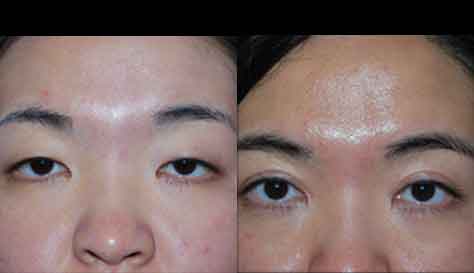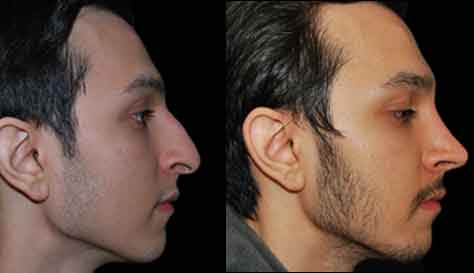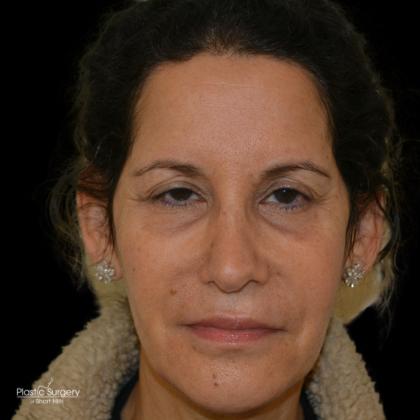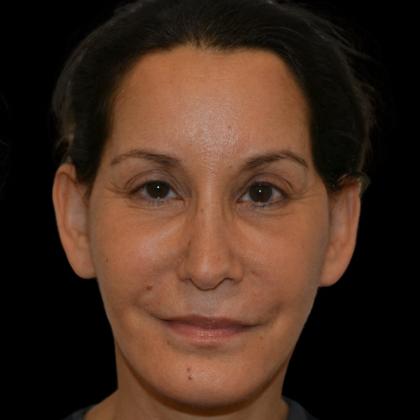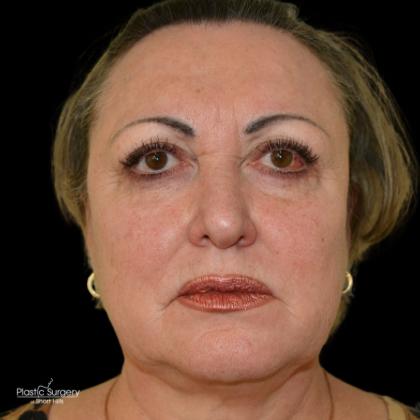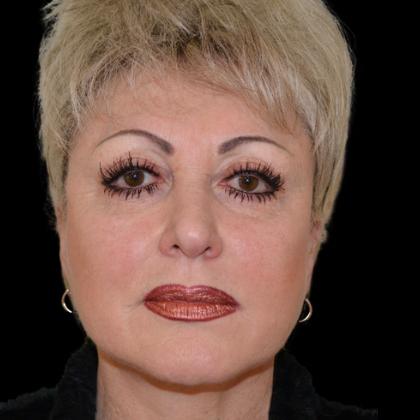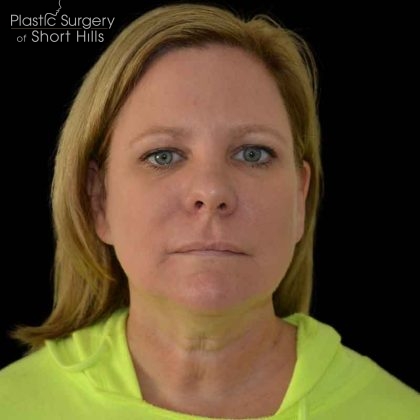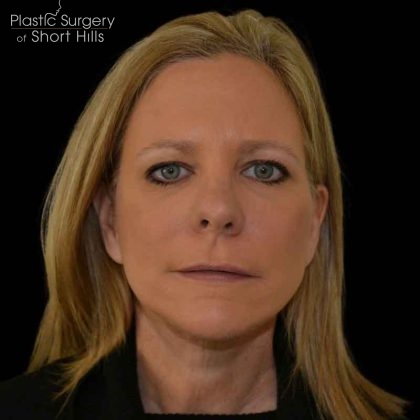Deep Plane Facelift
Conveniently located to serve the areas of New Jersey and New York

A deep plane facelift is a type of facelift surgery that addresses the symptoms of aging in the middle and lower parts of the face and neck, including sagging skin, jowling, neck muscle bands, and skin laxity. The procedure differs from a traditional SMAS facelift as it involves more extensive soft tissue dissection and release underneath the skin, which normally extends to the level of nasolabial folds, jowls, and neck bands. This more extensive release of soft tissues and their anchoring ligaments allows for better lifting, repositioning, and tightening of the soft tissues of the face than what a traditional SMAS facelift typically offers.
The deep plane facelift is a very technically demanding surgery that requires a detailed knowledge of the anatomy of the face and neck, and therefore it is not routinely performed by many surgeons. Dr. Alexander Ovchinsky, a renowned facial plastic surgeon, offers expertly performed deep plane facelifts for many patients of any age, with more emphasis on those patients who display moderate to severe signs of facial aging. With superb treatment from Dr. Ovchinsky, you will feel confident in your new face, and rest assured that you will look natural and youthful. To learn more, schedule a consultation at Plastic Surgery of Short Hills in New Jersey or Brooklyn by calling (973) 379-0101, or by contacting us online.
Before and After Photos
Contents
- 1 Before and After Photos
- 2 About Deep Plane Facelifts
- 3 Benefits of Deep Plane Facelifts
- 4 Who is a Candidate for Deep Plane Facelift?
- 5 Personal Consultation
- 6 Preparation
- 7 Deep Plane Facelift Procedure
- 8 Recovery
- 9 Results
- 10 Corresponding & Complementary Procedures
- 11 How Much Do Deep Plane Facelifts Cost in New Jersey?
- 12 FAQ
- 13 References
About Deep Plane Facelifts
Age-related changes in facial skin, soft tissues, muscle, and bone structure combined with the effects of gravity ultimately result in visible signs of facial aging. These can include facial sagging, laxity, jowling, double chin, and the appearance of neck bands and skin wrinkles. These changes in facial appearance can make you look older, less energized, and healthy than you really are. For many people, appearing older can be a cause for great psychological strain. Even though they still feel vital and full of life, their face tells a different story. Non-invasive treatments and a healthy lifestyle can only do so much to stop the natural progression of aging and its aesthetic impact. Luckily, facial plastic surgeons like Dr. Ovchinsky offer their expertise and artistry to give their patients a new lease on life.
What is Different About the Deep Plane Technique?
A deep plane facelift addresses signs of facial aging at a more fundamental level. In a standard SMAS facelift, the surgeon primarily focuses on the conservative and partial elevation of SMAS, tightening the SMAS and removing excess skin and fat to restore a more youthful appearance. While being quite effective in younger patients with less facial laxity, a SMAS facelift may not provide adequate and long-lasting effects in certain cases, especially for patients with significant sagging or laxity in the deeper tissues of the face.
A deep plane facelift goes beyond the partial release of the soft tissues of the face and targets the deeper structures, including the full undermining and release of the SMAS layer and associated malar fat pad and connective tissues. By fully releasing and mobilizing these structures, a surgeon can more effectively lift and reposition droopy facial tissues while still maintaining a natural, albeit much younger, facial appearance. This technique allows for greater lifting and tightening of the midface, jawline, and neck, resulting in a more comprehensive facial rejuvenation.
Benefits of Deep Plane Facelifts
There are several benefits to receiving a deep plane facelift. The particular perks of the deep plane technique include:
- Providing more natural-looking and longer-lasting results
- Allowing for better and more comprehensive correction of facial laxity
- Addressing loss of volume in the midface by effectively repositioning soft tissues to fill the area
- Requiring less tension on the skin to maintain tightness (1)
Who is a Candidate for Deep Plane Facelift?
While patients of any age can be good candidates for deep plane facelifts, this procedure is geared more towards patients with more substantial signs of facial aging. The patients should also be willing to undergo a longer surgery and slightly longer recovery due to more swelling that results from a deep plane approach. The ideal candidate is in good overall health, is a non-smoker, and has realistic expectations about the outcomes. Although age is not necessarily a limiting factor for the deep plane procedure, patients must be healthy enough to undergo surgery, without any serious or uncontrolled conditions that could affect its success or their healing ability during recovery.
Personal Consultation
At your consultation, Dr. Ovchinsky can provide you with all of the information you need about the deep plane facelift procedure. He can answer any questions you may have and will walk you through the specific details of the surgery and how you can benefit from the outcomes. He will examine the areas of your face you wish to change, paying close attention to the key areas of your facial anatomy and the specific areas you wish to address. We will talk with you about your beauty goals and let you know what is possible with the deep plane method.
You can expect to answer some questions about your medical history, so come prepared to give information about your past surgeries, health conditions, and current medications and allergies, as well as your smoking and/or nicotine use habits.
To schedule your consultation at Plastic Surgery of Short Hills, call (973) 379-0101 or fill out this form.
Preparation
Preparing for your deep plane facelift is a crucial aspect of your treatment success and will help avoid possible complications and allow for quicker recovery. As soon as we schedule your surgical date, there are ways that you can begin preparing. If you smoke or use any nicotine products, you should quit as early as you can before your procedure, at a minimum of two weeks before the surgery. Smoking and any nicotine use significantly compromises small blood vessels bringing blood to the skin and soft tissues. This may result in very serious complications during and particularly after the surgery such as wound breakdown, skin slough off, and necrosis.
You should also discuss with Dr. Ovchinsky if you are taking any blood thinner medications and discontinue those at least 1 week before the surgery. Management of certain blood thinner medications may also require the involvement of your primary care physician. Tight blood pressure control in patients suffering from hypertension is also an essential step in preparing for facelift surgery. A well-balanced nutritious diet and good hydration will fortify your body for the effects of surgery. We will give you specific instructions for preparation based on the information we gather at your consultation. They will include further details about substances, medications, and activities to pursue or avoid.
Recovery from a deep plane facelift requires some downtime, so plan to take the necessary time off work to do so. We can let you know how much time we think you’ll need at your consultation. You will be in a sensitive state that requires rest and relaxation to heal, so you should prepare your home for recovery. Make sure everything you will need is within reach and that you have groceries stocked. Arrange for a ride to and from our facilities on the day of your surgery and for someone (a family member or a friend) to be around for at least the first 24 hours after your procedure.
Deep Plane Facelift Procedure
At Plastic Surgery of Short Hills, Dr. Ovchinsky performs deep plane facelifts on an outpatient basis, which means you can go home the same day as your surgery.
The surgery is done under general anesthesia to fully eliminate any discomfort.
To begin, Dr. Ovchinsky will make small incisions in discreet locations around your ear and along the hairline. He will make them in deliberate locations and in such a fashion that will minimize the visibility of scars. He will then lift the skin and underlying superficial musculoaponeurotic system (SMAS) and malar fat pad as one flap. (2) He will then manipulate the SMAS flap and soft tissues and resuspend them in a more youthful and natural position. He will then remove excess skin and then close the incisions with very fine sutures. The neck tightening, if needed, is usually performed at the same time via a small incision in the natural crease under the chin. When he is finished, he will wrap your incisions and you will be monitored in a recovery room as the anesthesia wears off.
Recovery
Recovering from a deep plane facelift can take anywhere from two to three weeks of initial downtime, depending on your rate of healing. You can expect some facial swelling, bruising, tightness, numbness, and redness at the incision sites. You may resume gentle everyday activity as soon as you feel capable, though you should avoid strenuous activity until you have completely recovered. We will provide you with detailed instructions for your recovery, including how to take care of your incisions and any warning signs to watch out for. Dr. Ovchinsky can prescribe medication to manage any discomfort as well as antibiotics and antibiotic ointment to place over the sutures.
Results
Because of the swelling that will result from your deep plane facelift, your results will not be immediately final. Some patients choose not to go out in public because of the swelling, though they typically feel comfortable after two weeks of recovery. Swelling can take several weeks to resolve, but once it does you will be able to see the full results of your procedure. Your face will be noticeably tighter and smoother, with a more youthful air.
Corresponding & Complementary Procedures
Deep plane facelift can be combined with various other cosmetic facial procedures, but the most common complementary procedures performed alongside facelift to further enhance the results are:
Brow Lift
A brow lift is a cosmetic procedure that can smoothen the forehead and address a heavy, sagging brow. Oftentimes the same effects of aging that prompt a facelift can lead to deep wrinkles in the forehead and a drooping, overhanging brow that can sometimes obstruct vision. With a brow lift, a surgeon addresses these symptoms by making an incision in strategic areas of the forehead to remove excess skin and lift the brow.
Rhinoplasty
Rhinoplasty reshapes and resizes the nose for cosmetic and/or functional reasons. It involves a surgeon making incisions in the lower part of the nose to access, remove, and reposition skin, tissue, and cartilage, transforming its structure. Along with a deep plane facelift, a rhinoplasty could take your beauty to new heights.
Chin Implants
Chin augmentation, also known as genioplasty or chin implant surgery, is a surgical procedure that enhances the size and shape of the chin. By placing a custom-designed implant onto the chin bone, we can achieve a more balanced facial profile and improve overall facial harmony.
Lip Lift
A lip lift is a surgical procedure designed to enhance the appearance of the upper lip by shortening the distance between the base of the nose and the upper lip. This procedure aims to create a more youthful, fuller, and well-defined upper lip contour. It can also address concerns such as a thin or elongated upper lip, a lack of lip volume, or a downturned mouth.
To see what else we offer at Plastic Surgery of Short Hills, visit our blog.
How Much Do Deep Plane Facelifts Cost in New Jersey?
To find out how much deep plane facelifts cost at Plastic Surgery of Short Hills, call (973) 379-0101 or visit our contact page.
FAQ
What makes a deep plane facelift different?
The deep plane facelift is an advanced technique that targets the deeper layers of the face, specifically the muscles and deeper tissues beneath the skin. The surgeon lifts and repositions the muscles and tissues through strategic incisions, providing a comprehensive and long-lasting result. This technique is particularly effective for addressing moderate to severe facial sagging and jowls.
Is a deep plane facelift expensive?
While the initial expense of a deep plane facelift may be higher than that of a typical SMAS facelift, it is essential to consider the long-term value and cost-effectiveness. The deep plane technique can provide more natural-looking results with improved longevity, potentially reducing the need for additional touch-ups or revisions in the future. This can ultimately minimize the financial burden associated with multiple procedures over time.
What are the important factors to consider when choosing a deep plane facelift surgeon?
The most important factor to consider is the expertise and experience of the surgeon, as well as the quality of the facility and the aftercare provided. Choosing a reputable practice ensures that you are investing in the best possible outcome for your facial rejuvenation goals.
References
- Raggio BS, Patel BC. Deep Plane Facelift. PubMed. Published 2021. https://www.ncbi.nlm.nih.gov/books/NBK545277/
- Yang AJ, Hohman MH. Rhytidectomy. PubMed. Published 2021. https://www.ncbi.nlm.nih.gov/books/NBK564338/




